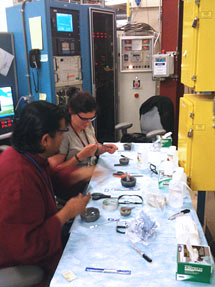
Handy Links
SLAC News Center
SLAC Today
- Subscribe
- Archives: Feb 2006-May 20, 2011
- Archives: May 23, 2011 and later
- Submit Feedback or Story Ideas
- About SLAC Today
SLAC News
Lab News
- Interactions
- Lightsources.org
- ILC NewsLine
- Int'l Science Grid This Week
- Fermilab Today
- Berkeley Lab News
- @brookhaven TODAY
- DOE Pulse
- CERN Courier
- DESY inForm
- US / LHC
SLAC Links
- Emergency
- Safety
- Policy Repository
- Site Entry Form

- Site Maps
- M & O Review
- Computing Status & Calendar
- SLAC Colloquium
- SLACspeak
- SLACspace
- SLAC Logo
- Café Menu
- Flea Market
- Web E-mail
- Marguerite Shuttle
- Discount Commuter Passes
-
Award Reporting Form
- SPIRES
- SciDoc
- Activity Groups
- Library
Stanford
Around the Bay
SSRL Summer School Shines a Light on Sulfur
Nineteen graduate students, postdocs and researchers gathered at SLAC last week for the Stanford Synchrotron Radiation Lightsource Structural Molecular Biology Low-Z XAS Summer School.
The first such SSRL summer school since the late 1990s, the workshop focused on a technique called low-energy X-ray Absorption Spectroscopy. When conducting XAS, a researcher aims an X-ray beam at a sample and tunes the beam through a range of energies. Specific chemical elements absorb specific energies, so when just the right energy beam hits the sample, atoms of a particular element will eject electrons, providing information about the atom's electronic structure. In particular, the workshop covered low-energy ranges (from 2.4 to 4 kilo-electronvolts) and the element sulfur, a technique called "S K-XAS."
With applications in biology, chemistry, and environmental and materials science, S K-XAS and X-ray fluorescence imaging can be used to probe metal–sulfur bonds that make certain human proteins function, image where sulfur accumulates in a plant grown in sulfur-contaminated soil, and reveal the different forms of sulfur present in a soil sample, to name a few examples.
After a day of lectures on the experimental capabilities, techniques and applications of low-energy XAS by experts in the field, attendees spent the next three days conducting hands-on data collection and analysis at SSRL's beamlines 4-3 and 2-3.
"In the survey we put out at the end of the workshop, the participants said that they feel confident to come back and do experiments on sulfur compounds at these beamlines," said SSRL Staff Scientist Ritimukta Sarangi, who chaired the workshop with Staff Scientist Samuel Webb. "That was our goal—to show them how the beamlines work and make them independent. And at that I think we were very successful."
The SSRL Structural Molecular Biology program is supported by the National Institutes of Health National Center for Research Resources and the Biological and Environmental Research section of the Department of Energy Office of Science.
—Kelen Tuttle
SLAC Today, July 30, 2010
